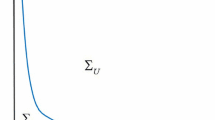Abstract
Many biological species increase their dispersal rate if starvation starts. To model such a behavior, we need to understand how organisms measure starvation and response to it. In this paper, we compare three different ways of measuring starvation by applying them to starvation-driven diffusion. The evolutional selection and coexistence of such starvation measures are studied within the context of Lotka–Volterra-type competition model of two species. We will see that, if species have different starvation measures and different motility functions, both the coexistence and selection are possible.






Similar content being viewed by others
References
Beck M, Wayne CE (2011) Using global invariant manifolds to understand metastability in the Burgers equation with small viscosity [reprint of mr 2551255]. SIAM Rev 53(1):129–153
Cantrell RS, Cosner C (2003) Spatial ecology via reaction-diffusion equations, Wiley series in mathematical and computational biology. Wiley, Chichester
Cho E, Kim YJ (2013) Starvation driven diffusion as a survival strategy of biological organisms. Bull Math Biol 75(5):845–870
Cohen D, Levin SA (1991) Dispersal in patchy environments: the effects of temporal and spatial structure. Theor Popul Biol 39(1):63–99
Desvillettes L, Lepoutre T, Moussa A, Trescases A (2015) On the entropic structure of reaction-cross diffusion systems. Comm Partial Differ Equ 40(9):1705–1747
Dieckman U, OHara B, Weisser W (1999) The evolutionary ecology of dispersal. Trends Ecol Evol 14(3):88–90
Dockery J, Hutson V, Mischaikow K, Pernarowski M (1998) The evolution of slow dispersal rates: a reaction diffusion model. J Math Biol 37(1):61–83
Hess P (1991) Periodic-parabolic boundary value problems and positivity, Pitman research notes in mathematics series, vol 247. Longman Scientific & Technical, Harlow
Holt R, McPeek M (1996) Chaotic population dynamics favors the evolution of dispersal. Am Nat 148:709–718
Hsu S, Smith H, Waltman P (1996) Competitive exclusion and coexistence for competitive systems on ordered Banach spaces. Trans Am Math Soc 348(10):4083–4094
Huisman G, Kolter R (2013) Sensing starvation: a homoserine lactone—dependent signaling pathway in Escherichia coli. Science 341:1236566
Hutson V, Mischaikow K, Poláčik P (2001) The evolution of dispersal rates in a heterogeneous time-periodic environment. J Math Biol 43(6):501–533
Johnson M, Gaines M (1990) Evolution of dispersal: theoretical models and empirical tests using birds and mammals. Ann Rev Ecol Syst 21:449–480
Kang S, Pacold M, Cervantes C, Lim D, Lou H, Ottina K, Gray N, Turk B, Yaffe M, Sabatini D (2013) mTORC1 phosphorylation sites encode their sensitivity to starvation and rapamycin. Science 341:1236566
Keeling M (1999) Spatial models of interacting populations, advanced ecological theory: principles and applications. J McGlade, (ed.) Blackwell Science, Oxford
Kim YJ, Kwon O, Li F (2013) Evolution of dispersal toward fitness. Bull Math Biol 75(12):2474–2498
Kim YJ, Kwon O, Li F (2014) Global asymptotic stability and the ideal free distribution in a starvation driven diffusion. J Math Biol 68(6):1341–1370
Kim YJ, Tzavaras AE (2001) Diffusive \(N\)-waves and metastability in the Burgers equation. SIAM J Math Anal 33(3):607–633 (electronic)
Lam KY, Lou Y (2014) Evolutionarily stable and convergent stable strategies in reaction-diffusion models for conditional dispersal. Bull Math Biol 76(2):261–291
Lam KY, Ni WM (2010) Limiting profiles of semilinear elliptic equations with large advection in population dynamics. Discret Contin Dyn Syst 28(3):1051–1067
McPeek M, Holt R (1992) The evolution of dispersal in spatially and temporally varying environments. Am Nat 140:1010–1027
Nagylaki T (1992) Introduction to theoretical population genetics, biomathematics, vol 21. Springer, Berlin
Ni WM (2011) The mathematics of diffusion, CBMS-NSF regional conference series in applied mathematics, vol 82. Society for Industrial and Applied Mathematics (SIAM), Philadelphia, PA
Okubo A, Levin SA (2001) Diffusion and ecological problems: modern perspectives, In: Interdisciplinary applied mathematics, (2nd ed.), vol 14. Springer, New York
Pao CV (1992) Nonlinear parabolic and elliptic equations. Plenum Press, New York
Seo HW (2013) Optimal selection under satisfaction dependent dispersal strategy, Master’s Thesis, KAIST
Skellam JG (1972) Some philosophical aspects of mathematical modelling in empirical science with special reference to ecology, mathematical models in ecology. Blackwell Sci. Publ, London
Skellam JG (1973) The formulation and interpretation of mathematical models of diffusionary processes in population biology, the mathematical theory of the dynamics of biological populations. Academic Press, New York
Travis JMJ, Dytham C (1999) Habitat persistence, habitat availability and the evolution of dispersal. Proc R Soc Lond B 266:723–728
Acknowledgments
This work was started when the second author was working at the Center for Partial Differential Equation in East China Normal University, Shanghai, China. He would like to thank all the hospitality and supports provided by the center during his stay.
Author information
Authors and Affiliations
Corresponding author
Rights and permissions
About this article
Cite this article
Kim, YJ., Kwon, O. Evolution of Dispersal with Starvation Measure and Coexistence. Bull Math Biol 78, 254–279 (2016). https://doi.org/10.1007/s11538-016-0142-8
Received:
Accepted:
Published:
Issue Date:
DOI: https://doi.org/10.1007/s11538-016-0142-8




